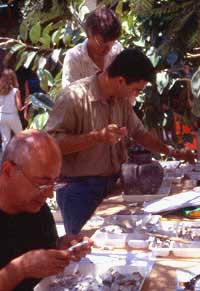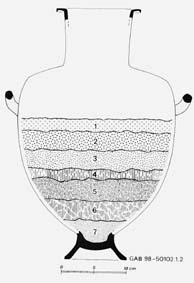FUNERARY PRACTICES
Cremation
Gilles Grévin, C.N.R.S. - Cépam U.M.R. 6130 Draguignan, Var. Paul Bailet, Laboratoire de recherches anthropologiques, Draguignan, Var.
In Ptolemaic Egypt (4th - 1st centuries BC), alongside the ancestral practice of mummification, there appeared that of cremation as introduced by the ruling Greek class. These two practices, which coexisted in the Necropolis of Alexandria, never the less, stand in opposition to each other in that they are attached to differing conceptions of the afterlife.

Fragments of burnt bones, the remains of bodies cremated on pyres, were collected and placed in terracotta hydria decorated with painted motifs, or in stone or alabaster urns. The methodical and "stratigraphical" investigation of these funerary jars and the study of their contents has provided some new information :
- contrary to previous belief, the bodies of women and children were, as with men, burnt on pyres.
- there exists an evolution in the style of cremation and collecting the burnt bones.
- in certain hydria the bone fragments were placed in an order that respects the anatomy of the body: feet towards the top or, in one attested case, the opposite. A less rigorous order is proof of less methodical collecting.
- in a hydra, the bones from the pelvic area are spotted with red. The colouring is cinnabar (natural mercuric sulphide) and must have been sprinkled on intentionally at the end of cremation.
- Two hydrias were found each accompanied by a vase containing ashes from the pyre. The very small fragments of bone and teeth found in these vases clearly belonged to the fragments held in the corresponding hydria.
Small flecks of cloth found in several urns and hydries may have been part of a piece of material used to envelop the bones collected after cremation : a practice attested in Homeric literature. Copper crowns with gold leaf imitating foliage and myrtle berries (a bush connected to funerary rites) sometimes accompanied the remains of the deceased. These were either placed on the shoulders of the hydria or burnt with the bodies, as their remains have shown.
Gilles Grévin and Paul Bailet - © CEA

The weight analyses and the statistical data that results take up a large part of the laboratory work. Undertaken for each anatomical section, these analyses permit an examination of diverse aspects of cremation in Ptolemaic Egypt. The work done by the Laboratoire d'analyses physique (CNRS, Cépam, UMR 6130) at Draguignan, Var, will benefit from the application of new data such as the comparative study of the attested funerary practices and the typo-chronology of the hydries, alongside comparisons with cremation in the Greek world and the teachings of ethno-archaeology. The results thus obtained should open wide areas for the archaeologists as much from the comprehension of cremation practices as from the analyses of the burnt bones.
Deliberate "stratigraphical" arrangement of fragments of burnt bones after cremation in anatomical order.
- small mixed fragments
- fragments of cranium
- vertebrae
- upper limbs
- hips
- lower limbs
- slivers and dust of bone
Drawing - © CEA